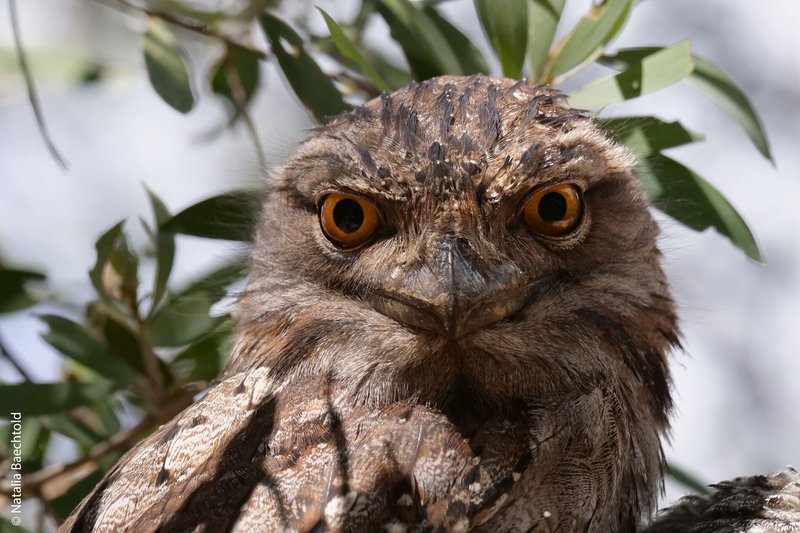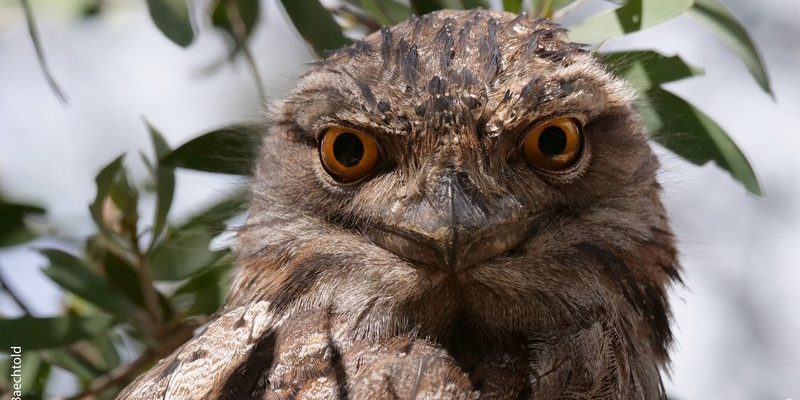
Have you ever heard of the Tawny Frogmouth? It’s a remarkable bird that might just fly under your radar. Unlike the more commonly known owls, this nocturnal creature has its own unique charm and characteristics that make it a fascinating topic to explore. With its striking appearance and intriguing habits, the Tawny Frogmouth is like nature’s version of a master of disguise.
Picture this: a bird that looks like a part of the tree it rests upon. The Tawny Frogmouth’s plumage is so perfectly camouflaged that it blends seamlessly into its environment. It’s as if Mother Nature equipped this bird with a cloak of invisibility! But there’s so much more to learn about this intriguing species. From its habitat and diet to its behaviors, we’re about to dive deep into the world of the Tawny Frogmouth.
Physical Characteristics
The Tawny Frogmouth is a medium-sized bird, typically measuring between 14 to 20 inches in length. Its wingspan can reach up to three feet, which is quite impressive for a bird that is often mistaken for a branch or log. One of the most defining features of this bird is its wide mouth, often described as resembling the frog it is named after. This is especially useful for catching insects during its nightly hunts.
Their plumage is predominantly a mottled brown with shades of grey, providing exceptional camouflage against the tree bark and branches where they perch. This ability to blend into their surroundings is crucial for avoiding predators and sneaking up on unsuspecting prey. Interestingly, their eyes are large and reflective, which enhances their night vision, allowing them to see in the dark.
Females tend to be slightly larger than males, which is not uncommon in the bird world. The Tawny Frogmouth also has long, slender toes and sharp talons that help it grasp onto branches securely. When you think about it, these adaptations are perfectly suited for a bird that spends most of its time resting motionless during the day and hunting under the cover of night.
Habitat and Range
The Tawny Frogmouth is native to Australia and parts of New Guinea and Tasmania. Primarily, you’ll find them in open forests, woodlands, and even suburban areas where there are plenty of trees. They prefer environments that offer both ample cover for resting and a healthy supply of insects and small animals for feeding. This adaptability is a significant reason why they thrive in various habitats.
Interestingly, during the day, these birds can often be spotted resting on a branch, their camouflage making them nearly invisible. It’s not unusual for people walking through the forest to walk past them without even realizing it. Their natural range stretches broadly across the continent, but they have been known to prefer areas where tree density is higher, making large forests their ideal home.
When it comes to nesting, Tawny Frogmouths don’t construct elaborate nests as many other birds do. Instead, they lay their eggs directly on a flat surface, such as a tree branch. The female typically lays 1 to 3 eggs, and both parents share incubation duties, which can last around 30 days. This cooperative parenting is critical for the survival of the chicks in their early, vulnerable days.
Diet and Hunting Behavior
The diet of the Tawny Frogmouth is primarily composed of insects, but they’re not picky eaters. They also consume small mammals, reptiles, and even small birds. Their wide mouths and nocturnal hunting habits allow them to snatch up prey in mid-flight or catch them while perched still. It’s fascinating how these birds are able to spot their food under the cover of darkness!
Using their excellent camouflage, they often remain motionless for extended periods, waiting for the perfect moment to strike. When a prey item approaches, they launch themselves into action—using their powerful talons to capture it. This hunting strategy is incredibly effective and showcases the Tawny Frogmouth’s evolutionary adaptations for survival.
Another unique aspect of their hunting behavior is their use of their impeccable hearing. They can detect the slightest rustle of leaves or the sound of movement nearby. This auditory sensitivity is vital since many of their prey are also nocturnal and can move quickly. Their hunting methods rival those of more recognized nocturnal hunters, such as owls, making them equally impressive.
Behavior and Social Structure
Unlike many other bird species, Tawny Frogmouths are known for their somewhat solitary nature. They tend to form monogamous pairs that mate for life, which is heartwarming to think about! During the breeding season, these bonded pairs will fiercely defend their territory from other Tawny Frogmouths. They do this through vocalizations and displays that help establish their dominance.
In terms of their vocal behavior, they have a variety of calls that can be heard at night. The calls often sound like a low, mournful grunt, which can be quite eerie in the stillness of the night. You might be surprised to learn that these calls serve different purposes, including attracting mates and establishing territory.
When it comes to their daily routine, Tawny Frogmouths are strictly nocturnal. As night falls, they become active, hunting and calling to each other. During the day, they roost quietly in trees, relying on their extraordinary camouflage to stay hidden from any potential predators. This behavior allows them to rest while remaining safe in their natural environment.
Conservation Status
The Tawny Frogmouth is classified as a species of “Least Concern” by the IUCN. This means that they currently don’t face the immediate threat of extinction. However, like many wild animals, they can still be affected by habitat loss due to deforestation and urban development. It’s essential to stay aware of local conservation efforts that help protect their habitats.
In suburban areas, Tawny Frogmouths have adapted well and often take advantage of the trees planted in parks and gardens. This adaptability is a shining example of how some species can thrive even in changing environments. However, it also emphasizes the need for ongoing efforts to maintain natural habitats that support not just the Tawny Frogmouth but the entire ecosystem.
Conservationists emphasize the importance of preserving wooded areas and restoring habitats that benefit these unique birds along with countless other species. By protecting these environments, we help ensure that the Tawny Frogmouth and its kin continue to be part of our world for generations to come.
| Attribute | Details |
| Size | 14 to 20 inches in length |
| Wingspan | Up to 3 feet |
| Habitat | Open forests, woodlands, suburban areas |
| Diet | Insects, small mammals, reptiles, small birds |
| Geographic Range | Australia, New Guinea, Tasmania |
| Breeding | 1 to 3 eggs, both parents incubate |
| Conservation Status | Least Concern |
FAQ
What is the Tawny Frogmouth’s primary habitat?
The Tawny Frogmouth prefers open forests, woodlands, and urban areas with plenty of trees. They thrive where they can easily blend into their surroundings, which assists them in both hunting and hiding from predators.
Are Tawny Frogmouths social birds?
While they form monogamous pairs that mate for life, Tawny Frogmouths are generally solitary outside the breeding season. They establish territories that they defend vocally and physically against other Tawny Frogmouths.
What do Tawny Frogmouths eat?
Tawny Frogmouths have a varied diet that primarily consists of insects but can also include small mammals, birds, and reptiles. Their ability to snatch prey quickly at night is key to their hunting strategy.
How do Tawny Frogmouths communicate?
These birds communicate with a range of vocalizations, often described as low grunts. These sounds can help them establish territory and attract mates during the breeding season.
Are Tawny Frogmouths endangered?
No, Tawny Frogmouths are classified as a species of “Least Concern,” meaning they are not currently facing immediate threats of extinction. However, habitat loss remains a concern for their populations.
How do Tawny Frogmouths camouflage?
The Tawny Frogmouth’s plumage is mottled brown and grey, allowing it to blend seamlessly into the bark of trees. This natural camouflage is crucial for evading predators and catching prey.
What is the breeding behavior of Tawny Frogmouths?
Tawny Frogmouths generally lay 1 to 3 eggs, and both parents take turns incubating them for about 30 days. This cooperative effort helps ensure the survival of their chicks.
Where can I find Tawny Frogmouths?
These birds are native to Australia, New Guinea, and Tasmania. You can often spot them in open forests and even in suburban parks where trees are abundant.
How do Tawny Frogmouths hunt at night?
With excellent night vision and acute hearing, Tawny Frogmouths remain still and wait for prey to come close. They then swoop down to capture their food using their strong talons.
Do Tawny Frogmouths have any natural predators?
While Tawny Frogmouths are adept at hiding, they can still fall prey to larger birds of prey and mammals that threaten them, especially when they are out of their protective roosting spots.
What sounds do Tawny Frogmouths make?
Tawny Frogmouths produce a variety of low grunts and calls, particularly during the breeding season. These vocalizations can be quite eerie and are often heard during the night.
Can Tawny Frogmouths be kept as pets?
It’s generally not advisable to keep Tawny Frogmouths as pets. They are wild birds with specialized needs that are best met in their natural habitats. Additionally, keeping them in captivity could be detrimental to their health and wellbeing.

